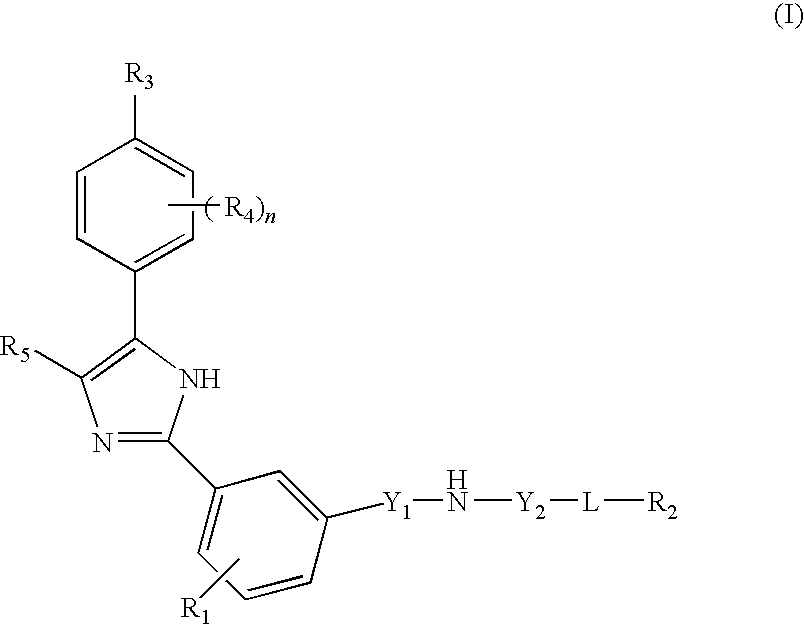Compounds and compositions as hedgehog signaling pathway modulators
a signaling pathway and compound technology, applied in the direction of biocide, plant growth regulator, biochemistry apparatus and processes, etc., can solve the problems of pathological consequences, and achieve the effects of reducing the expression level of genes, affecting the transmission of hh signals, and high proliferation ra
- Summary
- Abstract
- Description
- Claims
- Application Information
AI Technical Summary
Problems solved by technology
Method used
Image
Examples
example 1
R-[4-Chloro-3-(5-phenyl-1H-imidazol-2-yl)-phenyl]-[6-(2-methyl-morpholin-4-yl)-isoquinolin-1-yl]-amine
[0123]
Step 1. R-2-methylmorpholine hydrochloride:
[0124]
[0125]N-Benzylethanolamine (9.06 g, 60 mmol) is stirred with (R)-(+)-propylene oxide (6.96 g, 99%, 120 mmol) in a sealed tube at 45° C. overnight. Evaporation of the excess of propylene oxide in vacuo gives the diol residue which is used directly for the next step.
[0126]The diol is dissolved in dioxane (60 mL, anhydrous). KOH (10.08 g, 180 mmol, powder) and tris(3,6-dioxaheptyl)amine (200 mg, 0.62 mmol) are added and the mixture is cooled to 0° C. after which tosyl chloride (12.58 g, 66 mmol, in 60 mL anhydrous dioxane) is added dropwise. The reaction mixture is allowed to stir at 0° C. for 45 minutes after which it is warmed to room temperature and stirred for an additional 4 hours. The reaction mixture is filtered (to remove insoluble material, KCl, KOH) and the filtrate is evaporated in vacuo. HCl (2 N, 200 mL) is added to th...
example 2
R-[4-Chloro-3-(5-phenyl-1H-imidazol-2-yl)-phenyl]-[2-(2-methyl-morpholin-4-yl)-quinolin-5-yl]-amine
[0135]
[0136]Step 1. To a solution of 5-iodoquinoline (1.02 g, 4.00 mmol) in dichloromethane (20 mL) at 0° C. is added 3-chloroperoxybenzoic acid (1.35 g, 77% maximum, ˜1.5 eq.) and the mixture is stirred until reaction completed (monitored by LC-MS). Then the mixture is distributed between DCM (100 mL) and 10% solution of Na2CO3 (2×50 mL). The organic phase is further washed with HCl (1N, 50 mL) to extract the small amount of unoxidized quinoline derivatives and dried with Na2SO4.
[0137]Step 2. The N-oxide obtained is dissolved in anhydrous DCM (15 mL) and POCl3 (920 mg, 1.5 eq.) is then added. The mixture is refluxed 1 hour and cooled to room temperature before it is poured into a solution of Na2CO3 (10% aqueous, 80 mL) at 0° C. After 30 minutes, it is diluted with DCM (50 mL) and the organic phase separated and dried with Na2SO4. After evaporation, the residue is subject to column chr...
example 3
R-[4-Chloro-3-(5-phenyl-1H-imidazol-2-yl)-phenyl]-[2-(2-methyl-morpholin-4-yl)-[1,6]naphthyridin-5-yl]-amine
[0140]
[0141]Step 1. To a solution of 6-methyl-6H-[1,6]naphthyridin-5-one (made according to literature [3], 2.40 g, 15.0 mmol) in DCM (50 mL) at 0° C. is added 3-chloroperoxybenzoic acid (5.50 g, 77% maximum, ˜1.6 eq.). After 1 hour of stirring at 0° C., the reaction mixture is evaporated and the residue is dry-loaded to a short silica gel column and chromatographed (DCM:methonal=100:6) to give the 6-methyl-1-oxy-6H-[1,6]naphthyridin-5-one.
[0142]Step 2. The N-oxide obtained (2.20 g, 12.5 mmol) is heated with POCl3 (8.0 mL) at 105-110° C. until all N-oxide solid is dissolved. It is then cooled to and maintained at 60° C. over the weekend. After it is cooled to room it is poured into a solution of Na2CO3 (10% aqueous, 700 mL) at 0° C. After 30 minutes, it is extracted with DCM (250 mL×2) and the organic phase separated and dried with Na2SO4. After evaporation, the residue is sub...
PUM
| Property | Measurement | Unit |
|---|---|---|
| temperature | aaaaa | aaaaa |
| temperature | aaaaa | aaaaa |
| temperature | aaaaa | aaaaa |
Abstract
Description
Claims
Application Information
 Login to View More
Login to View More - R&D
- Intellectual Property
- Life Sciences
- Materials
- Tech Scout
- Unparalleled Data Quality
- Higher Quality Content
- 60% Fewer Hallucinations
Browse by: Latest US Patents, China's latest patents, Technical Efficacy Thesaurus, Application Domain, Technology Topic, Popular Technical Reports.
© 2025 PatSnap. All rights reserved.Legal|Privacy policy|Modern Slavery Act Transparency Statement|Sitemap|About US| Contact US: help@patsnap.com



